ABSTRACT
Radiation amplitude zeros can be considered as a manifestation of the conservation of the structural complexity of the interacting quantum systems. Different aspects of this
conguence is analyzed in this work. Through this analysis one can see that the structural complexity incorporates into itself the physical quantities existing before the
shift in Standard Model related symmetry and the physical quantities emerging after this event. The long existing questions, twins paradox of special relativity and ‘spooky
action at a distance’ questions are also briefly discussed in the domain of the structural complexity of the system.
Keywords: dependence of the structural complexity on the energy, the connection between the charges and masses of the elementary particles, radiation amplitude zeros,
conservation of the structural complexity, structural complexity and shift in the symmetry (spontaneous symmetry breaking), fundamental invariant physical quantities, twins
paradox, quantum dualism, ‘spooky action at a distance’, unobservable variables, electromagnetic waves and the structural complexity.
DOI:10.70784/azip.1.2025208
Received: 02.04.2025
Internet publishing: 22.04.2025 AJP Fizika E 2025 02 en p.08-10
AUTHORS & AFFILIATIONS
Institute for Physical Problems, Baku State University, Azerbaijan
E-mail: mail.quanta02@gmail.com
|
[1] F. Mamedov. Particle interactions, masses and the symmetry breaking, hep-ph/0606255
[2] F.A. Mamedov. SU(2)L x SU(2)R symmetry of the fermions and the vector bosons, the fermionic origin of the local gauge transformations, the visible traces of the flickering nature of the early stages of the universe's formation, AJP Fizika C, 2023
[3] Fizuli Mamedov. The connection between the energy and structural complexity of the matter, Structural complexity origin of the electroweak boson masses as well as metabolism in living organisms, AJP Fizika E, 2024
[4] Fizuli Mamedov. Structural complexıty of the materıals and superconductıvıty: how fundamental ıs the mechanısm ınducıng thıs phenomenon of nature, AJP Fizika E, 2025
[5] S. Eidelman et al., Review of Particle Physics, Phys. Lett. B 592, 1 (2004)
[6] R.W. Brown, K.L. Kowalski, and S.J. Brodsky. Classical radiation zeros in gauge theory amplitudes, Phys. Rev. D, 28:624, 1983.
[7] F. Mamedov. Radiation zeros in weak boson production processes at hadron colliders, hep-ph/0107326
[8] S.L. Glashow. Partial Symmetries of Weak Interactions, Nuclear Physics 22, (1961), 579
[9] S. Weinberg. A Model of Leptons, Physical Review Letters, 19, 1264
[10] A. Salam, N. Svartholm. Proceedings of the Eighth Nobel Symposium, Almqvist & Wiksell, Stockholm (1968)
[11] C.A. Reynolds, B. Serin, and L.B. Nesbitt. The Isotope Effect in Superconductivity. I. Mercury https://doi.org/10.1103/PhysRev.84.691
[12] Leggett, J. Anthony. (2022), Quantum liquids: Bose condensation and Cooper pairing in condensed- matter systems , Oxford: Oxford University Press. ISBN 9780192856944
[13] Binding energy per nucleon, http://barwinski.net/isotopes
[14] Krassimira Marinova, Istvan Angeli, Nuclear Charge Radii, International Atomic Agency, https://www-nds.iaea.org/radii
[15] Table of Isotopic Masses and Natural Abundances, https://www.chem.ualberta.ca/~massspec/atomic_mass_abund.pdf
[16] National Superconducting Cyclotron Laboratory, Laser precision studies of the nuclear radii. http://nscl.msu.edu/news/news - 25.html
[17] Size of helium nucleus measured more precisely than ever before. https://www.admin.ch/gov/en/start/documentation/media-releases.msg-id-82143.html
[18] F.A. Mamedov. Scaling properties of Dirac matrices, the gravitational field and consistently life like transformation law behavior aspect of these matrices. Dirac matrices and dark matter, AJP Fizika E, 2024
[19] J.E. Hirsch. BCS theory of superconductivity: it is time to question its validity, Phys. Scr. 80 (2009)
[20] P. Salucci, A. Burkert. Dark Matter Scaling Relations, arXiv:astro-ph/0004397
[21] Sam Walters. How Eintstein Got His Field Equations, arxiv.org/abs/1608.05752
[22] A. Einstein, B. Podolsky and N. Rosen. 1935, “Can quantum-mechanical description of physical reality be considered complete?”, Physical Review, 47: 777–780.
|
